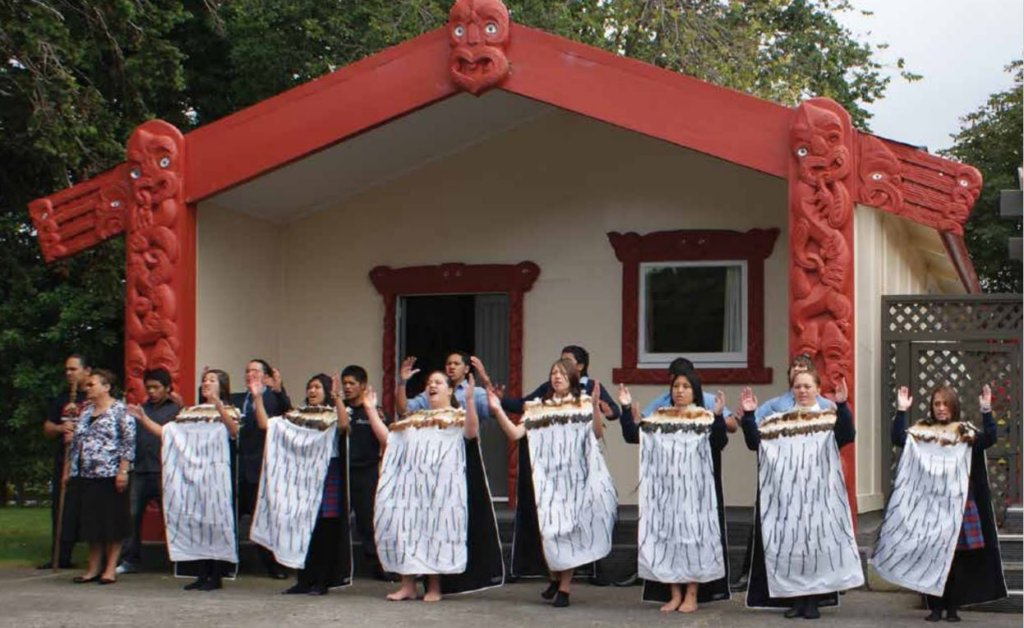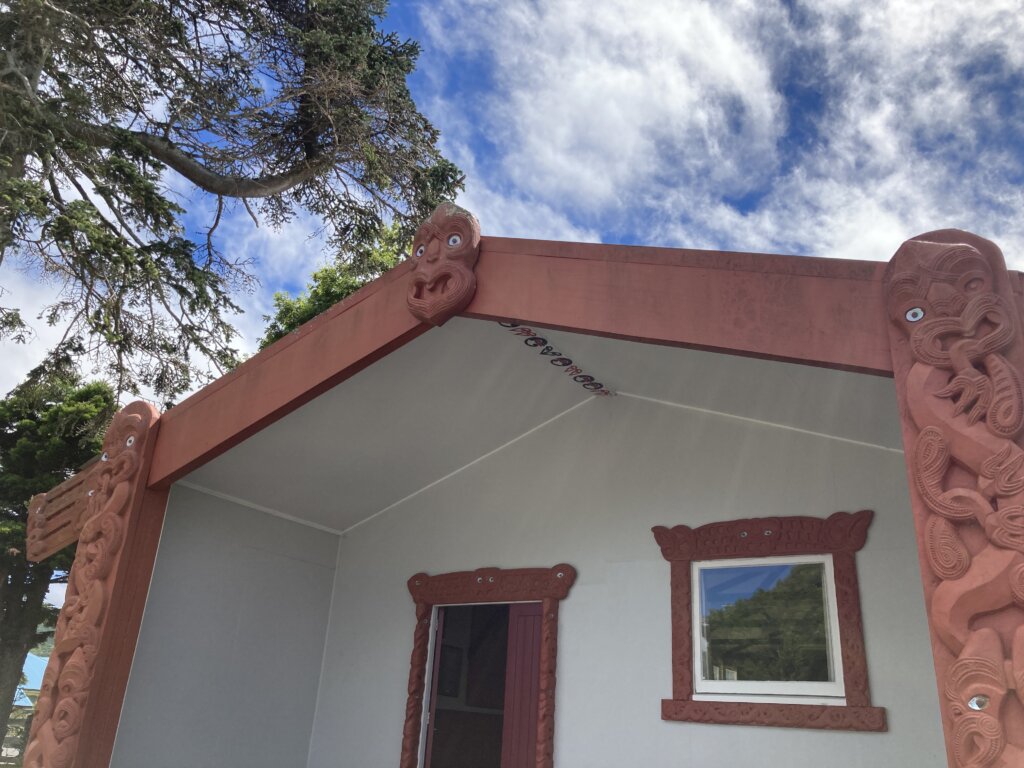Kia ora and welcome to Te Whānau Tahi Marae.
Te Whānau Tahi Marae is situated on Naenae College grounds and has a long and interesting history connected to many iwi around the Wellington region and up to Taranaki.
Structure
The wharenui was originally a prefab and was modified by staff members and the community.
The koruru (carved face on the gable) is the ancestor after whom the house is named. The two downward sloping bargeboards are maihi, representing his arms. At the end of the maihi are carved portions called raparapa, representing his hands. The two uprights on either side of the house are amo maihi – meaning ‘carrying the maihi on the shoulder’. The ridgepole or tāhuhu is his backbone, the rafters or heke are his ribs and the house itself represents his body.
Whakairo
The whakairo (carvings) on the front of this house are the style of North Taranaki, a style closely related to that of North Auckland and Hawaiki. The Taranaki carvings differ from the others in having a peak on top of the head, which reminds one of the mountain that dominates the district and the people of Taranaki.
Tīpuna
Kupe
The koruru, the large head at the apex of the house, has been named Kupe, who was the first man to have explored Wellington Harbour around 1300.
Whātonga, Tara and Tautoki
The left upright as you face the house has a figure on the top. This is Whātonga, one of three chiefs on board the Kurahaupō canoe. Whātonga landed at Mahia but later settled in the Hastings area. He built a house called Heretaunga, a name his descendants gave to the Hutt River.
Whātonga married Hotuwaipara and just before their first child was born he went fishing with his friends. On their return, fish were piled up outside their home. Hotuwaipara thought she would cook fish for her husband’s breakfast so she reached into the pile of fish. Unfortunately she badly lacerated her hand when she grabbed a porcupine fish. When her child was born, she named him Tara‐ika meaning ‘spikes of a fish’.
The descendants of Tara‐ika gradually moved out of Wairarapa, eventually settling in Wellington, the Hutt Valley and Porirua. They were called Ngāi Tara. Wellington Harbour was named after him too: Te-Whanganui-a-Tara or the great harbour of Tara.
Tara is the left figure on the lower part of the left maihi, below his father Whātonga. He is intertwined with his brother Tautoki, from his father’s second wife, Reretua.
Tautoki married Kupe’s great-granddaughter Waipuna and had a son, Rangitāne. His descendants are of the Rangitāne tribe, eventually including their relations, Ngāi Tara, then occupying Wairarapa, Wellington and the Manawatu areas.
Awanui‐a‐Rangi, Te Wharepouri and Te Puni
The right amo maihi has Awanui‐a‐Rangi, who is claimed to be an ancestor from the Ngāti Awa tribe. He also lived in North Auckland, Whakatane, Te Tini‐o‐Awa (an early tribe of the Hawke’s Bay region) and finally Te Atiawa of North Taranaki.
This tribe migrated south with Te Rauparaha and settled in Waikanae, then later moved into Wellington and the Hutt Valley about 1832. Te Atiawa are the people we acknowledge today as the tangata whenua.
The two figures at the lower part of the right amo maihi are Te Wharepouri on the left and Te Puni on the right. These two were the chiefs of Wellington and the Hutt Valley at the time of European settlement. They and their younger relation Wi Tako Ngātata treated the settlers with honour and never broke their word.
The late Sir Ralph Love was present at the unveilings of the carving on 8 November 1988, and is a great-grandson of both Te Puni and Wi Tako.
Pōwhiri
A Māori welcome onto a marae is called a pōwhiri (or pōhiri). This consists of two groups of people: tangata whenua (hosts) and manuhiri (visitors).
Māori is the language used during pōwhiri. While pōwhiri may vary according to the occasion and tribal area, Māori language still guides pōwhiri. Basic pōwhiri include the following steps:
Karanga
Calls are exchanged as a visiting group moves onto the marae or into the formal meeting area. The karanga usually indicates the start of the pōwhiri (formal welcome ceremony). Carried out almost exclusively by women and in the Māori language, karanga are initiated by the hosts.
Whaikōrero
Men generally make formal speeches during pōwhiri and in social gatherings. The whaikōrero is an opportunity for the speaker to display their mastery of Māori language, and a competent speaker is able to embellish their speech with imagery and metaphor.
Waiata
The group the orator represents sings a song after each whaikōrero. It is common to hear traditional waiata during pōwhiri.
Koha
A gift, generally an envelope of money, is laid on the ground by the last speaker for the manuhiri in a position between them and the tangata whenua. A local kuia (female elder) may karanga as an expression of thanks. A male from the tangata whenua will pick up the koha.
Hongi
Pressing noses signifies the joining together of tangata whenua and manuhiri. Tangata whenua invite the manuhiri to come forward to shake hands (harirū) and hongi.
Kai
A cup of tea will be provided in the dining room (wharekai – Ngā Rau O Ngā iwi). Following this the visitors are free to mingle with the tangata whenua and/or bring their baggage into Te Whānau Tahi Marae. This usually signifies the end of the pōwhiri.
Note: In the event of rain, the pōwhiri (welcome ceremony) will take place inside the wharenui (meeting house).
Kawa and tikanga
Kawa (protocols) and tikanga (customs) are not based on any tribal affiliations, however, it is advisable to contact the school for guidance on the kawa and tikanga of Te Whānau Tahi Marae. The kaumātua, the late Sir Ralph Love, supported this approach.
Tangihanga
A tangi takes precedence over all other functions on the marae. In the event of a death, your stay at Naenae College Te Whānau Tahi Marae could be curtailed or even cancelled so that the marae becomes available for the tangi. However, the marae committee will endeavour to do their best to relocate manuhiri.
History
1980 – Wharenui opened 21 June by Te Atiawa
1988 – Carvings unveiled by Sir Paul Reeves 8 November
1988–90 – Carvings completed under the tutelage of Jock McEwen
1989 – Wharenui partly burnt 3 April
1994 – Wharekai (Ngā Rau o Ngā Iwi) opened 8 October
Derek Wood (principal 1967–1980) initiated the building of the marae at the front of the school.


